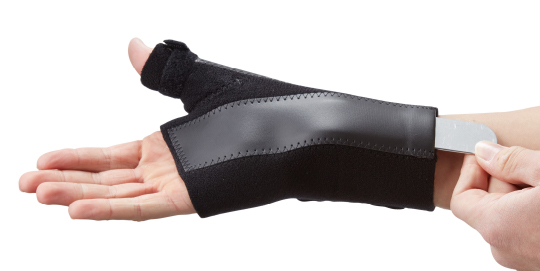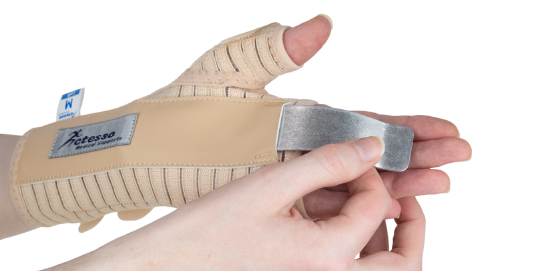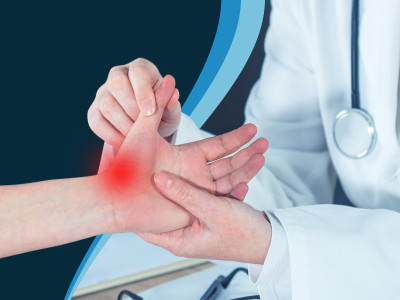Posted by Joe O'Mahony on 3rd Apr 2024
Scaphoid fractures make up around 15% of all wrist injuries. But what exactly is a scaphoid fracture? And what’s the best way to manage this type of wrist fracture to ensure a safe and effective recovery?
In today’s blog, we’ll answer those questions and more, including our product recommendations for immobilising the injured wrist. Let’s explore.
What is a Scaphoid Fracture?
A scaphoid fracture is when you break a carpal bone in your wrist known as the scaphoid (ska-foy-d) bone. This is the most common of the three carpal bones that people break due to its size and location in the wrist. It’s important to note that ‘break’ and ‘fracture’ both refer to a bone being broken by an external force, and both terms are used interchangeably. Medical professionals use the term ‘fracture’ as it is the correct medical term for the situation, and can be used along with words such as ‘transverse’ or ‘tubercle’ to describe a specific type of fracture.

The scaphoid fracture can be broken in three different areas, with the most common area being the waist of the scaphoid. This makes up more than 70% of scaphoid fractures.
Distal Fracture – Occurs at the end of the scaphoid bone, closest to the hand and fingers. This makes up 10% of scaphoid fractures.
Waist Fracture – The middle section of the scaphoid bone. As mentioned earlier, this makes up 70% of all scaphoid fractures.
Proximal Fracture – The other end of the scaphoid bone, closest to the forearm region. 20% of scaphoid fractures.

If you believe you have fractured your wrist, you should contact a medical professional – visit your GP or contact 111 for tailored advice on what steps to take next.
Causes of a Scaphoid Fracture
The most common cause of a scaphoid fracture is a direct fall onto outstretched hands. It’s a natural reaction to put your hands out when you fall forward, and this sudden impact on the wrists can cause damage to tendons, ligaments, and bones like the scaphoid bone. Scaphoid fractures can be inflicted by car accidents, sports injuries, or even an accidental fall in everyday life such as slipping on a wet or icy surface. There are also contributing factors:
Age - Scaphoid fractures are mostly seen in those aged under 30. This may be due to the increased activity levels of young adults and children, exposing them to higher risks of falling.
Existing Medical Conditions - Although scaphoid fractures are caused by event-based situations, having medical conditions such as osteoporosis, osteogenesis imperfecta (OI) or brittle bone disease increases the risk of fracturing your wrist in a fall. This is because your bones are less structurally strong than normal, and they can’t take as much impact without taking damage.
Symptoms of a Scaphoid Fracture
Symptoms of a scaphoid fracture are usually prominent and appear soon after an obvious event such as a fall. Symptoms include:
- Pain at wrist near the base of the thumb, also known as the anatomic snuffbox.
- Swelling of the hand.
- Tenderness on the palm and around the wrist.
- Bruising on the palm and around the area of impact.
- Limited mobility in the wrist joint.
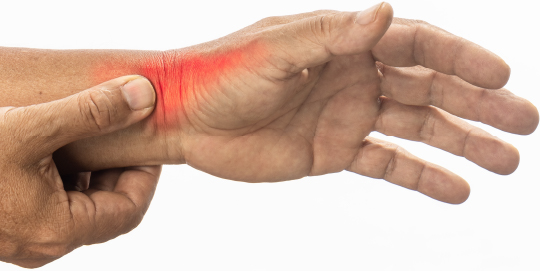
How is a Scaphoid Fracture Treated?
Diagnosis
A healthcare professional will talk to you about what symptoms you have been experiencing, as well as the severity of each symptom. They may also ask if you recall a specific event which may have caused these symptoms to occur – in the case of a scaphoid fracture, this would usually be the fall onto an outstretched hand that we mentioned earlier.
If they believe there is a possibility of a fracture, they will conduct a physical examination using equipment such as an X-ray machine. The X-ray should determine if there are any fractures and if so, how badly the bone is damaged.
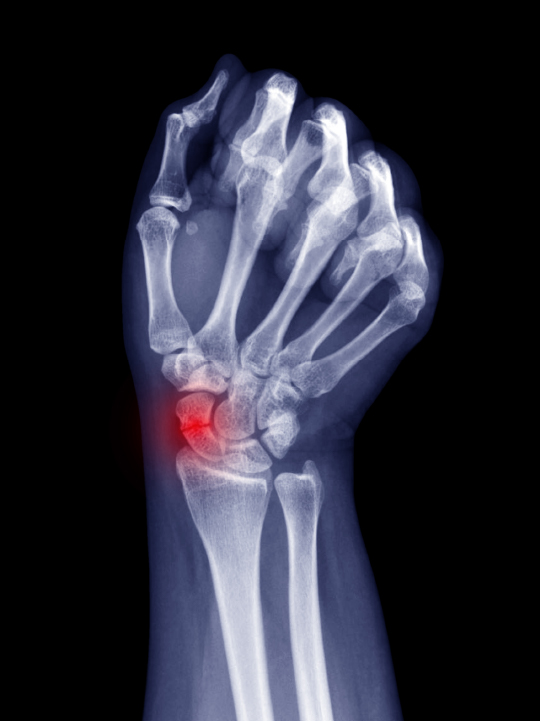
(However, this fracture is known for not initially showing up on x-ray scans due to its small size. Regardless of this, doctors will treat it as a fracture if they believe your symptoms and other factors point to a fracture.)
They may choose to use an MRI (Magnetic Resonance Imaging) machine to scan your wrist. The benefit of using an MRI over an X-ray is that an MRI produces multiple layers of images showing the tendons and tissue surrounding your bones. This can show the professional the severity of your condition in greater detail, and shows them if any surrounding tendons were damaged.
Rest & Immobilisation
Based on the severity of the fracture, the hospital may put your wrist in a cast for up to 12 weeks. By immobilising the wrist joint, the risk of further injury is reduced. The body will then have an opportunity to repair itself, healing the broken area of the carpal bone.
Those with non-displaced or minimally displaced fractures may be recommended to wear a wrist splint support. This will immobilise the wrist and thumb joint in a similar way to a short arm fiberglass cast, but is more breathable and can be easily removed for hygiene purposes. It is recommended that you wear your wrist splint throughout the day and overnight to ensure no damage is done to the wrist while you sleep. For this reason, people may choose a more ventilated designed support to prevent discomfort.
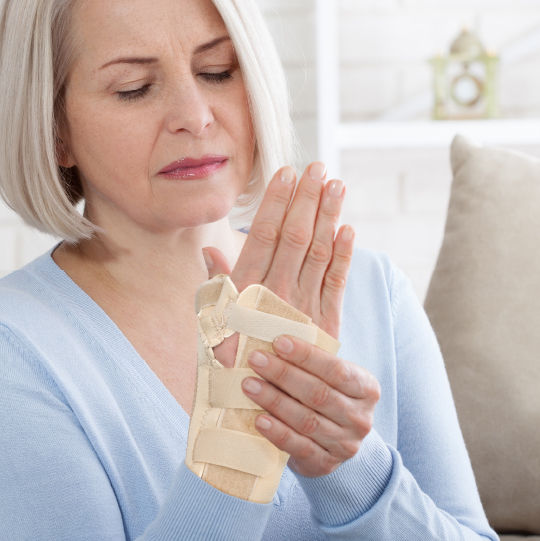
You should perform various finger stretches and exercises throughout the daytime to ensure your fingers don’t get stiff while in a splint or cast. This helps speed up the recovery process by maintaining mobility in unaffected digits, which will be used again once the cast is removed. Keeping the affected hand elevated whenever possible helps to reduce swelling in the wrist and thumb.
If you wear any rings or jewellery on the affected hand, this should be removed as soon as possible after the accident to avoid any swelling and circulation issues later on.
Surgery
In more serious fracture cases, surgery may be required. If the fracture has occurred at the waist of the scaphoid and caused more than 1mm of displacement, it most likely will need surgery as the injury has interrupted the blood supply to the bone.
Surgery would involve pushing the two broken pieces of the scaphoid back together with a small screw – this is to encourage healing for the two pieces to fuse back together.
Recommended Products for Scaphoid Fractures
For those with less severe cases of scaphoid fractures, a stabilising splint support is perfect for immobilising the thumb and wrist and encouraging the healing process. Read below to see what products we recommend for scaphoid fractures:
Actesso Neoprene Wrist & Thumb Support
The Actesso Neoprene Wrist and Thumb Splint Support is designed to immobilise the wrist and thumb joint for conditions such as scaphoid fractures, wrist sprains, and de Quervain’s tenosynovitis. With two metal splints, the support stabilises the wrist and all thumb joints in a neutral position. This is the optimal position for recovery as it puts the least amount of strain on tendons and muscles.
The ultra-soft neoprene material makes it suitable for all-day use - keeping your wrist comfortable and encouraging circulation to reduce swelling.
Actesso Breathable Wrist & Thumb Support
Similar to the Neoprene Wrist and Thumb Support, the Actesso Breathable Wrist and Thumb Support also has two metal splints to immobilise multiple joints.
However, this support is designed with a ventilated breathable material to keep the wrist cool overnight. It is recommended that you wear an immobilising splint overnight as you are likely to knock your wrist and cause further pain whilst you sleep.
Click the link below to learn more about the Breathable Wrist and Thumb Support and find the right support for you.
Conclusion
Scaphoid fractures are a serious wrist and thumb condition that should not be left untreated. If you think you have fractured your wrist, you should see a medical professional as soon as possible. Lack of treatment can lead to various conditions such as:
- Acute Compartment Syndrome – an increase in pressure which restricts blood flow to a specific point of the body.
- Malunion – where a fractured bone heals in an abnormal state.
- Nonunion – where a fractured bone fails to heal.
- Avascular Necrosis – where body tissue and bones deteriorate due to their blood supply being cut off.
- Arthritis – Known as post-traumatic arthritis, this is where arthritis develops in a joint due to a recent injury in the same area. This usually goes away after an amount of time, but for some people, this condition can be chronic (long-term).
For more information on reducing scaphoid fracture pains through wrist supports, contact Actesso today at info@actesso.co.uk.
Disclaimer: We are not qualified medical professionals. All information stated in this article has been taken from reputable sources.

